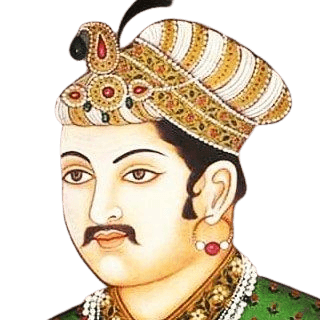Life and achievements
Early life
Akbar was born on October 15, 1542, in the Rajput fortress of Amarkot. His father, Humayun, was the second Mughal Emperor, and his mother, Hamida Banu Begum, was the daughter of a Persian Noble. After Humayun's defeat by Sher Shah Suri, the family was forced to leave the country. The early part of Akbar's life was spent in the mountains of Persia and Afghanistan.
Akbar was to be involved in warfare and governance despite having a rather unrooted childhood. He never went to school and was illiterate, but he had a good memory and a curious mind. His education consisted of listening to the reading of texts and engaging in discussions with scholars. Akbar ascended to the throne at thirteen, and Bairam Khan served as the empire's ruler, ensuring the young king was correctly guided.
Akbar was to avoid many challenges at the initial stage of his reign, both internally and externally. He was an excellent military commander and a strategist who helped expand and enhance the Mughal Empire. Akbar was a powerful ruler when he fully came to power in 1560.
Akbar's childhood and youth were filled with various military campaigns focused on protecting the empire and its expansion. His victories, the Second Battle of Panipat in 1556 against Hemu, and other battles fortified his rule. These campaigns also depicted Akbar as a fearless and brilliant commander who would always ensure that he and his army emerged victorious.
Some of the early policies he implemented further elaborated his policy of inclusion. Akbar ended the jizya tax on non-Muslims and admitted them into his service. He married Rajput princesses to increase the size of his kingdom and improve religious and cultural integration. This period also saw Akbar start his architectural activities, building forts and palaces to show the might of his empire.
Legacy
Akbar left a tremendous and diverse influence on society's military, administration, culture, and religion. His reign can be considered the age of the Mughal Empire when the empire was stable, prosperous, and creative. Thus, the idea of an empire encompassing all that Akbar had was the foundation for the following Mughal emperors.
Akbar's most famous and lasting accomplishments were his religious tolerance and efforts to create a united religion. He ceased collecting the jizya tax and granted important posts to non-Muslims, which fostered a feeling of unity. Though the Din-i Ilahi did not exist for a long time, it depicted Akbar's desire to move beyond the traditional religions and form a new one for everyone.
Akbar's administrative changes in the Mughal Empire were effective and had long-lasting impacts. He brought in a system of centralized administration, enhanced means of revenue collection, and a civil service system based on merit. These reforms enhanced the ability of the empire and its longevity, thus allowing it to exist and continue.
As for the culture, Akbar's patronage of art and culture led to the development of Mughal painting, architecture, and literature. His courts were centers of knowledge and innovation, and people worldwide became part of them. Through building construction, Akbar left his mark on the most famous structures, including Fatehpur Sikri, Agra Fort, Buland Darwaza, etc.
Akbar also saw the growth of the economy during his reign. He encouraged business, economics, and farming; thus, the economy was in perfect shape. Weights and measures were also standardized, trade routes were promoted, and economic integration and development existed.
Thus, Akbar maintained a strong and stable empire through negotiations and military prowess despite opposition and rebellions. Other kings copied his great diplomacy and administration of various territories under one king in the future. The Mughal Empire remained mighty even after Akbar through Jahangir and Shah Jahan.
Milestone moments
Feb 5, 1556
After Humayun died, Akbar, at the age of thirteen, became the Mughal king and ruled over India.
Bairam Khan's mentor helped smooth the power transition from Humayun to Akbar.
This began Akbar's reign, a period of Mughal imperialism.
Nov 5, 1556
Akbar's forces under Bairam Khan defeated Hemu, a Hindu king, in the Second Battle of Panipat.
This victory gave Akbar complete control over the city of Delhi and the country's northern parts, thus making him a mighty king.
Oct 1, 1562
Akbar married Mariam Zamani, a Rajput princess who strengthened the Rajput kingdoms.
This marriage depicted the religious tolerance of Akbar and the diplomatic marriage relationship.
Jan 1, 1575
Akbar created Ibadat Khana, or the House of Worship, at Fatehpur Sikri to discuss and argue on religious and philosophical topics.
This was evident in this initiative because Akbar wanted the different religious groups to have a way of communicating with one another.
